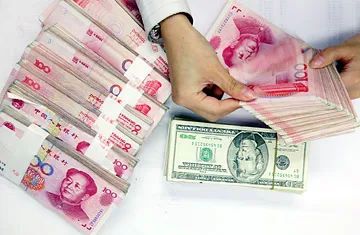
Inflation woes: Chinese economy in peril with a record 5.5% CPI inflation in May
And worse, it is likely to reach its peak at 6% yoy in June, says Credit Suisse.
Forecast of China’s GDP growth is therefore downgraded from to 8.5% from 8.9% in 2012, as the ‘mid-point’ softness emerges.
Here’s more from Credit Suisse:
| • The scenario of persistent inflation, slowing growth, and continued tightening is likely to play out not only in 2H11 but well into 2012, in our judgment. • We expect the financial stress observed at the SME level to spread to other parts of the economy. Banks have been dropping SMEs as a result of much tightened liquidity. If the situation does not improve soon, we would expect weakened demand and rising account receivables soon. • Export outlook has dimmed, squeezed by labour and power shortage on the one hand, and a sudden dip in orders from the US and Europe. We would not be surprised to see exports hit zero growth at some stage in 2H11. • Inflation is likely to peak soon, but it is expected to stay at elevated levels, as services inflation takes off. This structural inflation, driven by salary hikes, should stay for a long time. China is now experiencing normalization in wage growth, followed by normalization in inflation and monetary condition. • We do not anticipate monetary policy easing any time soon despite slower growth. Inflation should continue to surprise on the upside and Beijing does not want to send the “wrong” message to the property market. And the government does not mind seeing slower growth, if social stability is maintained, in our view. • Should the threat of a hard landing emerge, we would expect fiscal stimulus to come to the rescue, instead of monetary easing. Providing funding to policy housing and speeding up infrastructure projects would be the easy options. Selective consumer subsidies for white products and cars may happen again. Inflation seeking a new norm May CPI inflation at 5.5% yoy has set a new record for this cycle, and we expect the June figure to exceed 6% yoy, probably the peak in yoy terms. However, we do not think inflation will decline towards 3.5% as the optimists predicted. In fact, the nature of Chinese inflation is changing, in our view. In the past, inflation was driven by food prices, which tend to be transitory. In the future, it will likely be driven by services inflation, which is structural. Services inflation has jumped from 2% in 2010 to 4% in the first five months This is largely due to the surge in salaries, especially among the migrant workers. When peoples’ expectations of their future salary change, inflationary pressure becomes sticky. We believe 2011 will see a softening in food inflation (about 30% of the CPI basket) and a rise in services inflation (about 50% of the CPI basket). As the cost of healthcare, education, rents, utilities and recreation all go up, we project CPI inflation to fluctuate around 5%. We argue that Chinese inflation is seeking a new norm. After a prolonged period of wage deflation between the mid-1990s to the mid-2000s, wage growth is normalizing. This leads to the normalization of inflation, followed by the normalization of monetary condition. In the past decade, China’s CPI inflation averaged about 2%; in the next decade, we believe it will be around 5%. With that, interest rates have a long way to rise. Currently, inflation is at 5.5% while the one-year deposit rate is slightly above 3%. Such a large negative real interest rate gap must be narrowed, if not eliminated in the long run. (For more details on our view on China’s inflation, please refer to China: Medium intensity and persistent inflation, published 18 March 2011) |



![SBR 5 Lorem Ipsum News 2 [8 May]](https://cmg-qa.s3.ap-southeast-1.amazonaws.com/s3fs-public/styles/exclusive_featured_article/public/2025-05/a_hand_pointing_to_a_futuristic_technology_5b87c9d0e3_3.png.webp?itok=M3Hf-9XR)
![SBR 4 Lorem Ipsum [8 May Top Stories]](https://cmg-qa.s3.ap-southeast-1.amazonaws.com/s3fs-public/styles/exclusive_featured_article/public/2025-05/a_hand_pointing_to_a_futuristic_technology_5b87c9d0e3_2.png.webp?itok=2m5Wl0MX)


![Exclusive three SBR 12 Lorem Ipsum [8 May]](https://cmg-qa.s3.ap-southeast-1.amazonaws.com/s3fs-public/styles/exclusive_featured_article/public/2025-05/a_hand_pointing_to_a_futuristic_technology_5b87c9d0e3_11.png.webp?itok=8kn_UIfA)
![SBR 3 Lorem Ipsum [ Exclusive 2]](https://cmg-qa.s3.ap-southeast-1.amazonaws.com/s3fs-public/styles/exclusive_featured_article/public/2025-05/a_hand_pointing_to_a_futuristic_technology_5b87c9d0e3_1.png.webp?itok=YCyjLegJ)
![SBR 2 Lorem Ipsum [8 May]](https://cmg-qa.s3.ap-southeast-1.amazonaws.com/s3fs-public/styles/exclusive_featured_article/public/2025-05/a_hand_pointing_to_a_futuristic_technology_5b87c9d0e3_0.png.webp?itok=_cKD-29o)

![Video [Event News]](https://cmg-qa.s3.ap-southeast-1.amazonaws.com/s3fs-public/styles/event_news_featured_article/public/2025-05/screenshot-2025-05-08-at-4.58.53-pm_0.png.webp?itok=Kud35sMs)
![Event News SBR 9 Lorem Ipsum [8 may]](https://cmg-qa.s3.ap-southeast-1.amazonaws.com/s3fs-public/styles/event_news_thumbnail/public/2025-05/a_hand_pointing_to_a_futuristic_technology_5b87c9d0e3_8.png.webp?itok=DTh_dbYp)
![Event News SBR 9 Lorem Ipsum [8 May]](https://cmg-qa.s3.ap-southeast-1.amazonaws.com/s3fs-public/styles/event_news_thumbnail/public/2025-05/a_hand_pointing_to_a_futuristic_technology_5b87c9d0e3_7.png.webp?itok=vzDAzb6V)
![Event News SBR 8 Lorem Ipsum [8 May]](https://cmg-qa.s3.ap-southeast-1.amazonaws.com/s3fs-public/styles/event_news_thumbnail/public/2025-05/a_hand_pointing_to_a_futuristic_technology_5b87c9d0e3_6.png.webp?itok=jvHFc4P6)
![Video [Event News]](https://cmg-qa.s3.ap-southeast-1.amazonaws.com/s3fs-public/styles/video_thumbnail/public/2025-05/screenshot-2025-05-08-at-4.58.53-pm_0.png.webp?itok=yZnI0YBb)
![Video 1 SBR [8 May]](https://cmg-qa.s3.ap-southeast-1.amazonaws.com/s3fs-public/styles/video_thumbnail/public/2025-05/screenshot-2025-05-08-at-4.58.53-pm.png.webp?itok=9AAeRz_k)

 Advertise
Advertise

